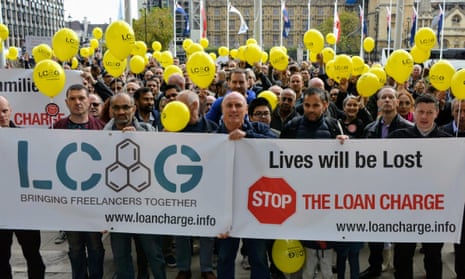It is turning into one of the ugliest, most emotional and turbulent battles ever fought between the tax authorities and alleged tax avoiders. The Money pages of the Guardian have rarely seen such a huge volume of angry, heartfelt letters from people who describe themselves as normal families whose lives are being destroyed, they say, by huge and unfair demands from HM Revenue & Customs.
The battle is over the innocuously named 2019 Loan Charge. This measure is designed to claw back unpaid taxes by people who, HMRC says, used so-called disguised remuneration schemes since April 1999 – with the demands for repayment kicking in from this April.
For some, the bills are utterly life-changing. We spoke to one family whose bill is more than £400,000 – owed by a 56-year-old who worked in IT for years and who says his only option now is bankruptcy.
Another IT worker said his estimated bill is £300,000. “I’m 54, have assets of £100,000 and earn less than £50,000 a year. I’ve already lost my partner due to the stress of this and have had suicidal thoughts. This will bankrupt me. All I did was follow advice and do what was the norm at the time. This all happened 10 to 20 years ago, and one of the clients at that time was HMRC.”
Not all were high-earning IT workers. We were contacted by a healthcare professional who was a locum in the NHS for two years. He said: “I was advised to sign up with an umbrella company by my agency [and] advised that they were fully compliant with HMRC, I would not have to worry about end-of-year paperwork because it was fully managed by them. There was never any mention of ‘loans’ at any point and I do not recall ever signing any paperwork agreeing to receiving my income through a loan.”
The person has been told they now face a tax bill of about £20,000.
So what were they doing that has resulted in such enormous bills? The heart of the issue is how contractors were paid using loans rather than salaries, thus sidestepping usual income tax and national insurance arrangements.
The schemes were hugely complex, but a simple example would be this. Let’s say the IT worker is hired for £3,000 worth of work. They are advised by their accountant to use an employee benefit trust (EBT), usually set up by a specialist company. The £3,000 is paid not to the IT worker but to the EBT, which then pays it back to them in the form of a loan, after some deductions for their fees. There is no tax paid on the £3,000, and the idea is that there is a mutual understanding that the loan will never be repaid. This is why HMRC calls it “disguised remuneration”. It’s also why many PAYE workers will have limited sympathy for the people receiving bills now, arguing that they were evidently sidestepping income tax.
HMRC has already contacted 40,000 people with loan charge demands, and in total it expects to pull in an extraordinary £3.2bn in tax. In its official guide to the loan charge, it says: “These loans are paid to people in such a way that means it’s unlikely that they’ll ever have to be repaid. In other words, the person receiving money from a loan scheme gets to keep it all. And they don’t pay any tax on this money, even though it’s clearly income. It’s highly unusual to receive your salary in loans and is clearly a method used to avoid paying tax.”
Such arguments enrage the people who have received the bills, who argue that they often had little or no choice when they were working as a contractor but to enter into these schemes.
They are astounded at the retrospective nature of the charges, often dating back more than a decade, long after their tax returns were officially closed, as well as HMRC’s refusal to accept reduced settlements, and what they say is their inability to challenge the charge.
Richard Horsley is co-founder of the Loan Charge Action Group. He says that many IT contractors such as himself fell into the loan schemes following measures at the end of the 1990s, known as IR35, to close tax loopholes used by some contractors.
“At the time, tax professionals and QCs came up with solutions where we went on to PAYE for a portion of our earnings, while another portion was a loan, which was not taxable. We asked if it was legal and were told yes. If we knew it was illegal we would never have allowed ourselves into it.”
He says in his case it meant that effectively 25% of his earnings went in deductions for tax, interest on the loans and the scheme promoter’s fees. But now he is subject to loan charges that effectively mean he will end up paying around 80% tax on his earnings for the period.
Another campaigner, who wished to remain anonymous, says: “We are just the fall guys. I was completely hoodwinked by the scheme administrators, and I feel that HMRC should have acted much, much sooner to advise me that these schemes were not legal. Genuinely naive contractors are being treated like horribly aggressive tax avoiders.” Why, he argues, is HMRC not going after the promoters of the schemes, many of which made millions, but have subsequently dissolved their companies?
Even the Low Incomes Tax Reform Group, which fights the corner for the low-paid and those on welfare, says in its guide to the charge that “some agency workers may have had little choice to participate in such schemes, if they wanted to work.”

Many MPs are now backing the loan charge workers. This week saw the launch of the all-party parliamentary loan charge group, chaired by Sir Ed Davey MP. He says: “There has been considerable concern raised about the loan charge by MPs and peers. With tens of thousands of people facing life-changing bills, it is vital that the loan charge is properly examined before it comes into effect on 5 April.”
Inside government, those in charge of collecting the levy see it very differently. Officials speak of an unprecedented campaign by those affected by the tax charge, talking darkly about how their social media accounts are bombarded with messages, how anyone who dares to defend the charge is attacked, and how HMRC workers have been individually targeted.
We asked HMRC to justify why it is reaching so far back in time for payments, and why it did not act earlier to stop the schemes – and the bills that have now racked up for contractors.
It says: “We’ve always been clear that these schemes do not work, warning against the use of tax avoidance schemes in the media and in publications such as our Spotlight series on gov.uk as early as 2009. HMRC have opened tens of thousands of inquiries into these schemes starting before 1999, making users and their representatives aware that their tax return was under investigation.”
It argues that the loan charge is not retrospective. It said: “It is unfair to ordinary taxpayers to let anybody benefit from contrived tax avoidance of this sort, and that is why the government has taken action to ensure that everybody pays the taxes they owe.
“The charge on disguised remuneration (DR) loans is not retrospective. It is a new charge, arising at a future date, on loan balances outstanding at that date. It does not change the tax position of any previous year or the outcome of any open compliance checks. Its announcement at budget 2016 provided scheme users with a three-year period to repay their DR loans, or to agree a settlement with HMRC before the charge takes effect.”
It denies that it is not chasing the scheme promoters. “Since the formation of HMRC’s fraud investigation service on 1 April 2016, more than 15 individuals have been convicted for offences relating to arrangements which have been promoted and marketed as tax avoidance schemes and sentenced to over 95 years custodial.”
Burned by suggestions that it is chasing low-income locum nurses and social workers, HMRC analysed the occupations of the people sent charge notices. “We estimate that of the 50,000 people affected, 3% are nurses and less than 2% are social workers.”

Comments (…)
Sign in or create your Guardian account to join the discussion